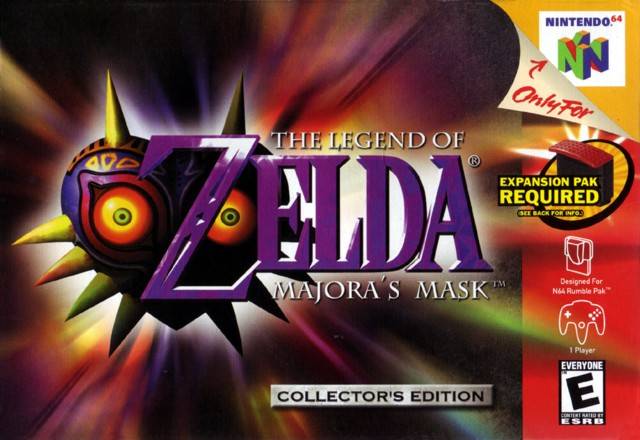
|
| Developer: Nintendo |
| Publisher: Nintendo |
| Released: October 26 2000 |
| Regions: NA, PAL, JP |
| Genre: Action/Adventure |
| Multiplayer: 1 player |
| Cart Size: 32MB / 256Mbits |
| Saving: Cartridge |
| Rumble Pak?: Yes |
| Expansion Pak? Yes |
| - Required? Yes |

|
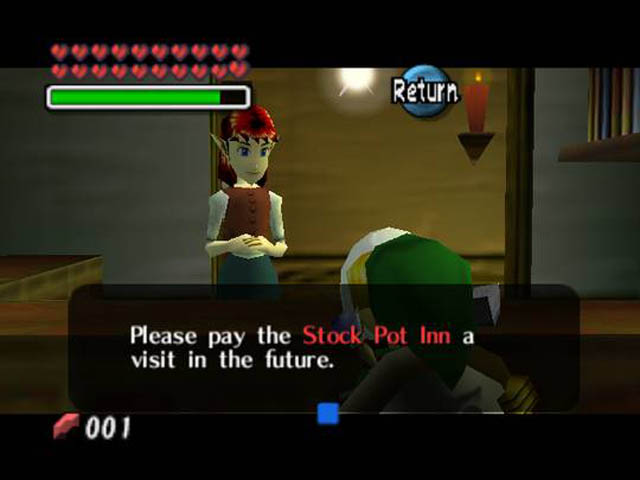
|
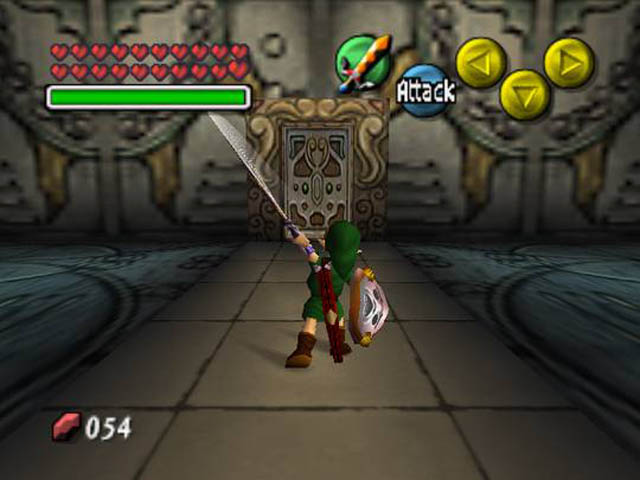
|
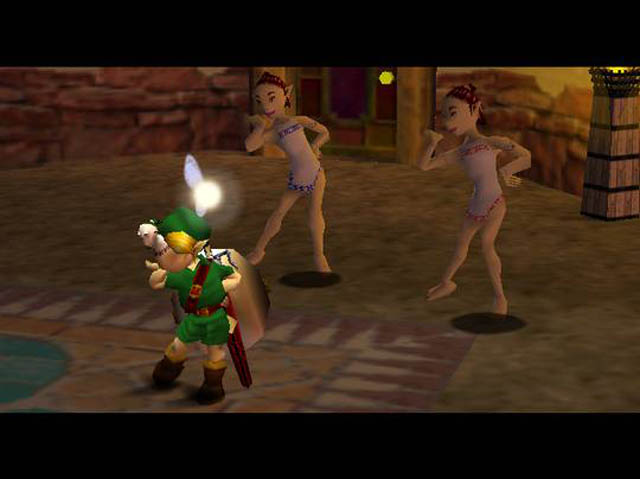
|
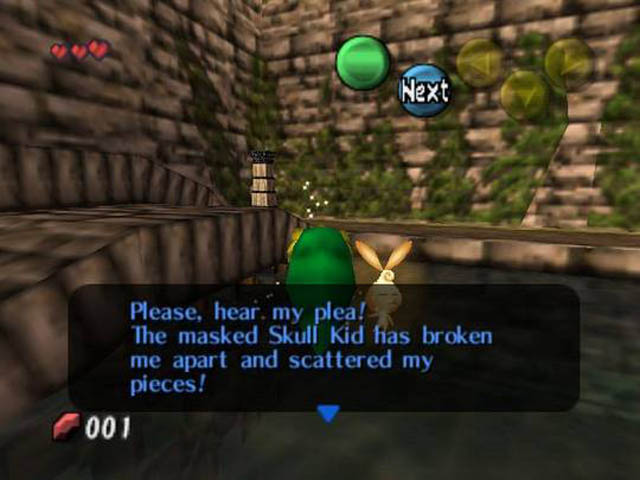
|
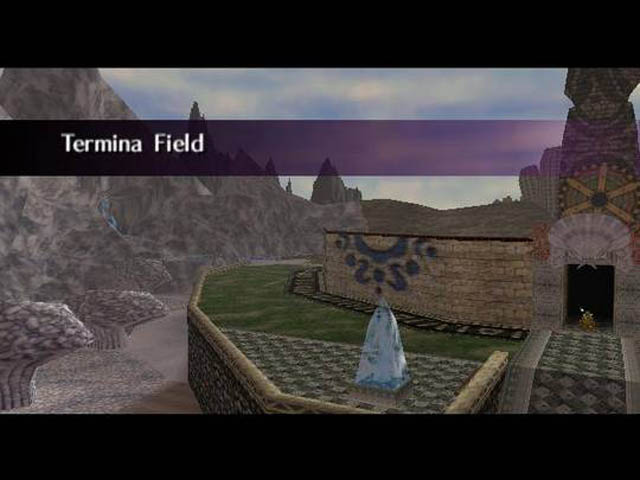
|
You've met with a terrible fate, haven't you?...
How does one make a follow-up to what is considered one of the greatest N64 games of all time? This was a question Nintendo was faced with after the release of Legend of Zelda: Ocarina of Time in 1998. Right from day 1, Ocarina of Time proved to be a big seller, helping the N64 to weather the PlayStation storm. This popularity, along with preceding lofty goals within development, lead Nintendo to come up with some sort of sequel to Ocarina of Time. For anyone who kept up with magazines back then, Ocarina of Time had quite a long history of big ideas and gameplay concepts. After Ocarina of Time, these same 64DD-driven rumors influenced the upcoming Ocarina of Time sequel, as it began to materialize. For some, the sequel was going to be Ura Zelda, an expansion to the original OOT. In reality, we ended up getting something entirely different in 2000, Majora's Mask, and Ura Zelda wound up dropping far below expectations a few years later. This particular article focuses on Majora's Mask, one of the most controversial Zelda games ever made. Fans argue about the dark setting, the time limit, lack of dungeons, recycling of graphic assets from Ocarina of Time and numerous other subjects. All of these and the game itself are at the center of this review.
Unlike most Legend of Zelda games, there is no Ganon, Triforce or much of Princess Zelda for that matter. It still stars Link, in his child form from Ocarina of Time, much to the dismay of most fans. Instead of Navi the Fairy, he is accompanied by Tatl, who has a more interesting personality and thus is less annoying. Most importantly, Tatl uses bell sounds to indicate things of importance, not "Hey!" and "Listen!". Link and his replacement fairy begin their adventure in the land of Termina, an oddly named alternate-universe sort of take on Hyrule where a lot of characters share uncanny resemblances to ones found in Ocarina of Time and are all under threat of a giant moon which is on a collision course straight for Clock Town, the focal point of the game. Early on, Link encounters Skull Kid, whom Ocarina of Time fans would know, who is now wearing a creepy looking mask that holds immense power. Seemingly undaunted by Skull Kid, Link becomes intertwined with the fate of Termina rather haphazardly. Even if all will be destroyed by a large moon, Link saved Hyrule from the king of evil himself, Ganondorf. What's one little rock falling out of the sky compared to that?
I like to think most people have already played Ocarina of Time and know how to play it, and therefore will be able to pick up and play Majora's Mask without impediment, but I will explain the controls anyway. Majora's Mask plays in a third person perspective, you use the A button to attack B to cancel things. The C-Left, C-Down and C-Right buttons hold inventory items, C-Up allows you to look around the world from a first person perspective. The Z button allows you to focus the camera on things using the legendary Z-Targeting System which made Ocarina of Time famous (though this had been used somewhat in earlier non-Nintendo games). R button lets you use a shield and you move with the analog stick. Just about every move or function that is an extension of the basic controls is explained in some way or another during the game.
Like the Ocarina being a defining inventory item in Ocarina of Time, the main driving force behind the game design mechanics of Majora's Mask is masks. These were actually a part of Ocarina of Time as a small side quest, but served no real function or purpose. Majora's Mask took this under underutilized idea (like many from Ocarina of Time) and drastically reinvented it to not only be useful, but very clever in a few different ways. In order to save Termina, Link will have to collect these masks and use them where appropriate. Three in particular are paramount to progress in the game, the transformation masks. There is a Deku, Goron and Zora mask. Yes, you can actually BE these species in Majora's Mask. Each has significant usage and vastly improves the game by adding a great deal of variety where Ocarina of Time was rather lacking.
Similarly, many of the inventory items and tools from Ocarina of Time made the transition into Majora's Mask, with some being modified to suit the child-only adventure Link is in. Link no longer needs the Fairy Slingshot or Deku Shield, now he has a Fairy Bow and a properly sized Hylian shield that he can use like normal. Other tools like the Hookshot are a mix between two (Hookshot and Longshot) from Ocarina of Time and now only one is needed. Some, like the Eye of Truth, are unchanged and work the same way as before. While not an actual inventory item, one thing missing a lot of people notice is the fishing rod. Yes, you cannot go fishing in Majora's Mask, this was replaced with the Doggy Race Track. While this is an unfortunate exclusion, it was probably only ever intended as a fun side attraction to the real adventure in Ocarina of Time. I for one feel a betting game can't replace a game of skill like fishing, but if the exclusion of such a mini-game meant Majora's Mask could be improved further, I'm all for it.
Being a direct sequel to Ocarina of Time, there are numerous advantages and drawbacks to address. The first and most noteworthy positive is the similar but vastly improved engine. Majora's Mask feels just as precise and easy to play as Ocarina of Time, but many behind-the-scenes improvements were made, such as longer draw distances, better textures and actual area transitions, where even the mini-map changes in real time. All of this was made possible with the Expansion Pak, which really made a huge difference for a game of this sort where there's lots of content on screen.
For each positive, there's also something people complain about. One of several is the 3 day time limit imposed early on in the game. Every Zelda game up to this point did not have any form of a time limit (except for maybe a sidequest here and there), so for Majora's Mask to adopt one was very polarizing. Some people felt it restricted their freedom, others argue it tightened the quality of the game significantly. I am far more inclined to agree that the time limit was definitely for the better, primarily because it greatly improved the story by setting limitations in which the plot and background stories can be written (rather than leave it more open like in Ocarina of Time) and all the quests and dungeons could receive similar increased quality by restricting what can happen and when. Some Zelda fans argue you're never allowed to explore areas and problem solve your way through dungeons. This is completely untrue; the game allows plenty of time to do all that. I suspect any who complains does not know about the Song of Time's two additional uses. There is the Song of Double Time which allows you to advance 12 hours ahead in time, great for completing time sensitive side quests. The other variation is The Inverted Song of Time, which slows down the flow of time by about a third, meaning your 3 days in-game turn into several hours of real time gameplay. You learn about both of these when you talk to the scarecrow found in two places in Clock Town, one of which is accessible very early in the game. If several hours of uninterrupted game time per usage of the Song of Time isn't enough to convince you, consider it is possible (and proven) to complete Majora's Mask within the 3 day time limit, using the Inverted Song of Time and without using the Song of Time to return to the first day. The time limit in Majora's Mask is very misunderstood, which is a very depressing thought as it makes this game one of the freshest feeling Zelda games ever.
Another flaw that is often mentioned is the abnormally dark tone of Majora's Mask, as mentioned before in this review. For some people, a Zelda game should be more about classic fantasy where the villain only has so much capacity for evil and the hero always triumphs, in a safe and predictable manner. This is Ocarina of Time in a nutshell. Majora's Mask was different, very different. The villain has access to the greatest threat of them all, complete and utter destruction of the world in which the story takes place. There is not much time for the hero to turn the tides either, only 3 in-game days. Ocarina of Time never really felt all that urgent, especially when you become Adult Link and Ganondorf has already laid waste to Hyrule. In Majora's Mask, the entire world will be destroyed entirely within 72 hours, that is a ton of urgency. This level of tension allowed for the true underlying qualities of Legend of Zelda to distill and heighten in potency. The setting of Majora's Mask gave Nintendo the ability to craft a really thrilling story that still felt very true to Legend of Zelda at the same time. It also allowed for a lot of exposition through sidequests and the four dungeons, which leads us to a more or less related subject of polarization.
Majora's Mask re-used graphical assets from Ocarina of Time. Not many sequels have ever actually done this, so for a lot of people, it was really strange seeing the follow-up to the best game of 1998 reusing characters and textures. It wasn't just a few either, most characters in Majora's Mask are repurposed from ones that appear in Ocarina of Time. Lots of new enemies and characters were added of course, along with new textures and all-new areas to explore, but you often see characters like Ingo, Malon (both young and adult) and the various townspeople being referred to by new names. This would all come across as cheap if not for the fact that Majora's Mask makes far better use of all those characters. Almost every otherwise nameless and boring townsperson from Ocarina of Time now has a backstory, things they do during the 3 day time period and how they are coping with the imminent destruction of Termina. Take the Cuckoo Lady from Ocarina of Time, there was little to her besides her allergy to Cuckoos. In Majora's Mask, she runs an inn in Clock Town, has a family, is part of a lengthy sidequest and Link's actions determine whether she evacuates Clock Town or becomes part of one of the more tragic moments of the game. Even just with this one character alone, the recycling of content was well worth it. Majora's Mask tells a far more interesting story than Ocarina of Time and every reused character benefitted immensely.
Perhaps the most discussed deviation from the norm is the lack of dungeons. Majora's Mask only has 4 main dungeons, Ocarina of Time had 8 in total. Out of context, this looks like Majora's Mask has less content. What most forget is Majora's Mask has an extensive assortment of sidequests to do. There's also a couple mini-dungeons where you hunt for gold skulltulas in exchange for items you'll need to access more sidequests. There's also far more heart pieces in Majora's Mask, 52 in total. There is a lot of content to go around here. Not as much as Ocarina of Time mind you, but Majora's Mask holds its own. Besides, Majora's Mask has a much better story, thus better incentive behind completing each dungeon and sidequest, so it all evens out.
With all these supposed flaws and possible others, it's important to keep in mind that such a game as Majora's Mask is really not the kind of game that will appeal to everyone. Some will never appreciate it because it's different. That's what makes it so great though. This polarizing reception and perception that Majora's Mask attracts is not only what allows great Zelda games to be defined, but it also makes people think of Zelda games in a different light. The numerous fan theories about the vague and barely explained sections of the story in Majora's Mask is a testament to this. Majora's Mask might actually be one of the best video game sequels ever made. It is the polar opposite of Ocarina of Time in many respects, while also being significantly connected and related to it. It reinvents many gameplay aspects of Ocarina of Time, while preserving others at the same time. It's these kinds of realizations and more that define Majora's Mask as an incredible game that is still clearly misunderstood even to this day.
Graphically speaking, Majora's Mask is one of the N64's finest titles, save for a few issues. It still felt a little stale if you were more wowed by high end PC games from 1998, even more so in 2000 with the Dreamcast having thoroughly blown the minds of everyone late the previous year, but Majora's Mask didn't simply port over old graphics entirely, much of the game was re-built from the ground up to fit the new story. With the expansion pak, Majora's Mask has far better draw distances, more detailed textures and not a single pre-rendered background in sight (*coughocarinaoftimecough*). Despite all that though, the polygon models for re-used assets weren't really improved much, making the game feel more 1998 than 2000. Any newly created models and textures look much better however. Even then, Ocarina of Time (and thus Majora's Mask) was never a really powerhouse sort of game, graphics wise. There was always too much happening on and off screen and too much different content for Rareware level graphics. For an action/adventure game like Majora's Mask, it looks fantastic, but it doesn't quite touch the upper crust of the N64 library in the eye-candy department. At the very least, the polished up GUI button graphics made Majora's Mask feel extra fancy.
In a similar manner, the music and sound effects of Majora's Mask are not necessarily better than in Ocarina of Time, but that's not a bad thing either. Most of the newly composed soundtrack is excellent, envoking many Zelda-like qualities while being fresh at the same time. Even the overworld theme from Legend of Zelda on NES was included (in the Termina Field area), among other classic Zelda songs. The sound effects are still very crisp and befitting like they were in Ocarina of Time. Similarly, voice samples are kept at a minimum. With so much content elsewhere in the game though, it's tough to imagine there being significant voice work included. The only possible downside here is Majora's Mask doesn't really improve over Ocarina of Time, it's merely on par.
In summarization, Majora's Mask is ultimately both an enigma of Zelda games and a defining jewel of the N64 console. To this very day, Majora's Mask still incites both love and hatred from fans (when they're not arguing whether Ocarina of Time was any good to begin with) and is a game that occupies nearly all top ten best N64 game lists. It's hard to think that a game developed in just two years, using the same engine and some assets as Ocarina of Time, could do all that and more. Its stark contrast to Ocarina of Time and the Zelda series as a whole is but one aspect that defines Majora's Mask as a great sequel and an even greater Zelda game. True innovation is always met with confusion, appreciation and hatred. Majora's Mask is just that, the most innovative Zelda game to date.
Presentation: 10
Nintendo knocked it out of the ballpark with the tragic setting, looming threat of destruction and compelling story of Majora's Mask. Few N64 games can compare.
Graphics: 8.5
While just as good - if not better - looking as Ocarina of Time, Majora's Mask was starting to look a bit dated compared to the competition of its day, both on the N64 and elsewhere. Stylistically, it's a fantastic game that still holds up today.
Sound: 8.5
Similarly just as crisp and iconic as Ocarina of Time. Lots of great new music pieces made it in, with a few instances of classic Zelda tunes sneaking their way in.
Gameplay: 9.0
Being built with the Ocarina of Time engine, Majora's Mask is just as intuitive and easy to play as its forerunner. All the new puzzles and abilities just sweeten the deal.
Lasting Appeal: 9.0
Despite there being fewer main dungeons, Majora's Mask will keep you busy with all its side quests, heart pieces and masks to collect. Those who replay Ocarina of Time will find just as much incentive within Majora's Mask as well.
Overall: 9.0
Written by Aaron Wilcott
March 29 2015
|